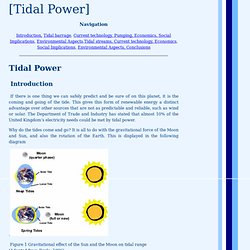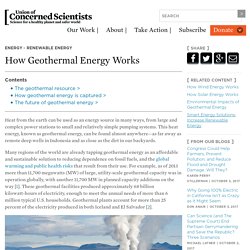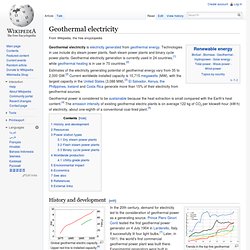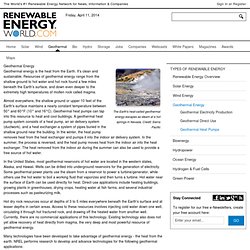

How much does it cost to build a geothermal power plant. Geopower2.gif (GIF Image, 337x256 pixels) Tidal Energy. As of July 1, 2013 ThinkQuest has been discontinued.

We would like to thank everyone for being a part of the ThinkQuest global community: Students - For your limitless creativity and innovation, which inspires us all. Teachers - For your passion in guiding students on their quest. Partners - For your unwavering support and evangelism. Parents - For supporting the use of technology not only as an instrument of learning, but as a means of creating knowledge. Tidal power. [Tidal Power] Navigation Introduction, Tidal barrage, Current technology, Pumping, Economics, Social Implications, Environmental Aspects,Tidal streams, Current technology, Economics, Social Implications, Environmental Aspects, Conclusions Introduction If there is one thing we can safely predict and be sure of on this planet, it is the coming and going of the tide.

This gives this form of renewable energy a distinct advantage over other sources that are not as predictable and reliable, such as wind or solar. Why do the tides come and go? Figure 1 Gravitational effect of the Sun and the Moon on tidal range (Adapted from Boyle, 1996) Sourced: (ACRE) Australian CRC for Renewable Energy LTD The diagram shows how the gravitational attraction of the moon and sun affect the tides on Earth.
The rotational period of the moon is around 4 weeks, while one rotation of the earth takes 24 hours; this results in a tidal cycle of around 12.5 hours. Top State of the art / Current Status Introduction top. Tidal power. Why is geothermal energy sustainable. Pros for Wave and Tidal Power. What is tidal energy?

Tidal energy is one of the oldest forms of energy used by humans. Indeed, tide mills, in use on the Spanish, French and British coasts, date back to 787 A.D.. Tide mills consisted of a storage pond, filled by the incoming (flood) tide through a sluice and emptied during the outgoing (ebb) tide through a water wheel. The tides turned waterwheels, producing mechanical power to mill grain. We even have one remaining in New York- which worked well into the 20th century. Tidal power is non-polluting, reliable and predictable.Tidal barrages, undersea tidal turbines – like wind turbines but driven by the sea – and a variety of machines harnessing undersea currents are under development. Tidal energy can be exploited in two ways: By building semi-permeable barrages across estuaries with a high tidal range.By harnessing offshore tidal streams. Barrages allow tidal waters to fill an estuary via sluices and to empty through turbines.
What is the impact on the environment? Tidal power. How Geothermal Energy Works. Heat from the earth can be used as an energy source in many ways, from large and complex power stations to small and relatively simple pumping systems.

This heat energy, known as geothermal energy, can be found almost anywhere—as far away as remote deep wells in Indonesia and as close as the dirt in our backyards. Many regions of the world are already tapping geothermal energy as an affordable and sustainable solution to reducing dependence on fossil fuels, and the global warming and public health risks that result from their use. For example, as of 2013 more than 11,700 megawatts (MW) of large, utility-scale geothermal capacity was in operation globally, with another 11,700 MW in planned capacity additions on the way [1]. These geothermal facilities produced approximately 68 billion kilowatt-hours of electricity, enough to meet the annual needs of more than 6 million typical U.S. households. Iceland's Nesjavellir geothermal power station. The geothermal resource References: [2] U.S. Binary Cycle Power Plant. Flash Steam Power Plant. Dry Steam Power Plant. Geothermal electricity. Geothermal electricity is electricity generated from geothermal energy.

Technologies in use include dry steam power plants, flash steam power plants and binary cycle power plants. Geothermal electricity generation is currently used in 24 countries,[1] while geothermal heating is in use in 70 countries.[2] Estimates of the electricity generating potential of geothermal energy vary from 35 to 2,000 GW.[2] Current worldwide installed capacity is 10,715 megawatts (MW), with the largest capacity in the United States (3,086 MW).[3] El Salvador, Kenya, the Philippines, Iceland and Costa Rica generate more than 15% of their electricity from geothermal sources.
Geothermal power is considered to be sustainable because the heat extraction is small compared with the Earth's heat content.[4] The emission intensity of existing geothermal electric plants is on average 122 kg of CO 2 per kilowatt-hour (kW·h) of electricity, about one-eighth of a conventional coal-fired plant.[5] Resources[edit] Geothermal Energy - Renewable Energy World. Geothermal Energy The Earth's heat-called geothermal energy-escapes as steam at a hot springs in Nevada.

Credit: Sierra Pacific Geothermal energy is the heat from the Earth. It's clean and sustainable. Resources of geothermal energy range from the shallow ground to hot water and hot rock found a few miles beneath the Earth's surface, and down even deeper to the extremely high temperatures of molten rock called magma. Almost everywhere, the shallow ground or upper 10 feet of the Earth's surface maintains a nearly constant temperature between 50° and 60°F (10° and 16°C).